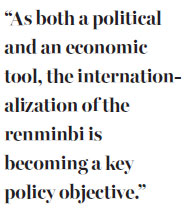Assessing the RMB's multinational role
When it comes to the clout of its currency, the world's second-largest economy punches significantly below its economic weight
Of all the important spheres of economic influence, the international monetary system has been the most rigid in responding to China's unprecedented growth and development.
From the absolute level of annual GDP growth and the scale of foreign exchange reserves, to the share of global investment in renewables and other technologies - and countless other metrics - China has risen to occupy the top spot globally.
Yet when it comes to the clout of its currency, the world's second-largest economy punches significantly below its economic weight. While the renminbi has gained ground over the past decade, it is still only the fifth-most-used currency in terms of payments, making up just 2 percent of the global total.
The picture for reserves is similar. Only 38 countries hold renminbi in their official reserves, with the total value of renminbi holdings equal to $75 billion (70.5 billion euros) - equivalent to just 1.1 percent of total official reserves globally.
This discrepancy, far from being accidental, is the result of the cautious attitude of Chinese policy-makers in terms of aligning the country's rapid economic growth with the opening of its capital markets.
This approach is now changing.
As both a political and an economic tool, the internationalization of the renminbi is becoming a key policy objective. This is reflected in several initiatives, including the creation of new multilateral investment banks such as the Asian Infrastructure Investment Bank and the New Development Bank, as well as the proliferation of central bank swap agreements.
These agreements enable central banks to exchange local currency at fixed rates, ensuring that they can withstand balance of payments pressures when facing market shocks and destabilizing currency fluctuations. This is particularly important for economies that have (or want to build) strong trade and investment links with each other.
China is now the largest or second-largest trading partner for most of the world economy.

This creates important incentives for many central banks to hold greater amounts of renminbi in their foreign reserves that can be supplied to domestic banks and to companies that face short-term funding constraints for their foreign currency activities.
Since late 2008, 36 central banks have signed currency swap agreements with China, totaling $500 billion. (3.3 trillion yuan). These include central banks in major advanced-economies - the European Central Bank, Bank of England, Bank of Canada, Swiss National Bank, the Monetary Authority of Singapore and the Reserve Bank of Australia - but also central banks in emerging economies such as Argentina, Pakistan and Thailand.
The renminbi's entry into the International Monetary Fund's special drawing rights currency basket on Oct 1 was an important milestone in consolidating the currency's status as a reserve currency, joining the dollar, euro, pound sterling and yen. Apart from acting as a ceremonial seal of approval, a practical implication of the renminbi's SDR inclusion is to elevate the importance of China's swap agreements.
Under existing SDR arrangements central banks that draw renminbi under swap agreements can subsequently convert it into SDR and then into dollars, which means that swap agreements with China now grant these central banks access to international liquidity via an indirect channel.
Although such international considerations are important to the growing appeal of the renminbi, the currency's fate crucially remains tied to that of the Chinese economy.
While fears over a hard landing have abated compared with the periods of high financial market volatility in mid-2015 and early 2016, China's success in rebalancing its economy, deflating its high debt pile and avoiding the middle-income trap without experiencing a recession, is far from secured.
Despite these doubts, the momentum of the renminbi remains strong. Another expansion area in the infrastructure for internationalization is the promotion of the renminbi as a benchmark currency for commodities.
This includes an already launched renminbi-denominated benchmark price for gold. Oil could follow next, as China seeks to avoid exchange rate risks and to hedge against shocks in oil-exporting regions, which in turn would see increased incentives for raising their renminbi holdings.
This multitude of initiatives to actively promote the internationalization of the currency, together with the growing foreign acceptance and interest in the renminbi as reflected in its SDR inclusion, sets the scene for a new era in Chinese policy-making where the rise of the renminbi will be one of the principal, if not the most important, characteristics in a phase of rebalancing and transition. In turn, China's growing monetary influence will with time come to challenge the dollar's hegemony, consolidating a new era in the global monetary landscape, that of the multicurrency system.
The author is head of research in the Official Monetary and Financial Institutions Forum, a London-based independent advisory group for worldwide public-private sector interaction in finance and economics. The views do not necessarily reflect those of China Daily.
(China Daily European Weekly 12/09/2016 page8)


















